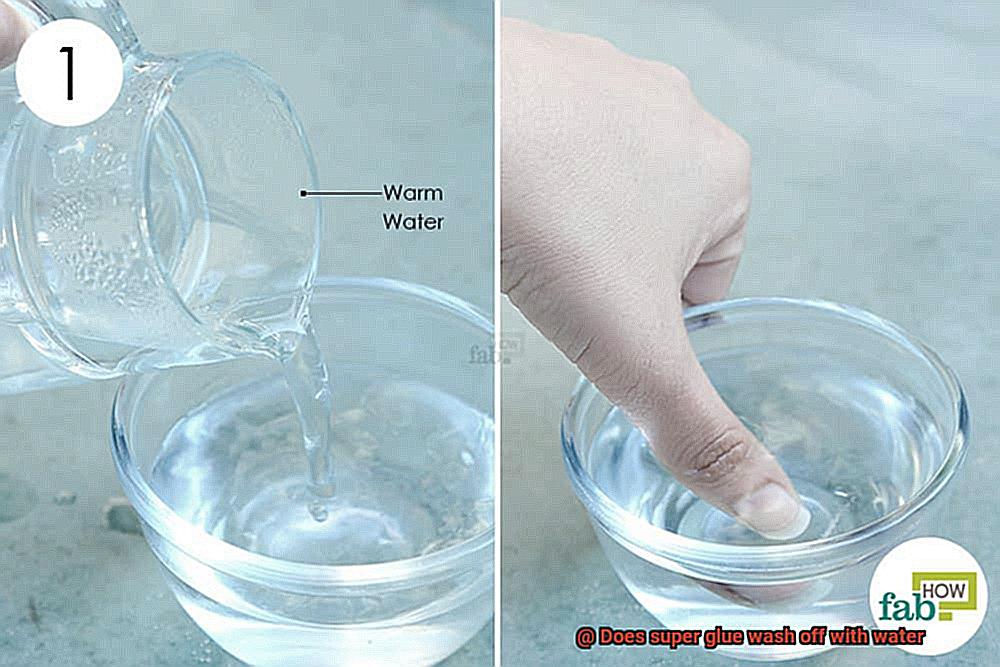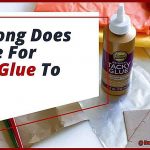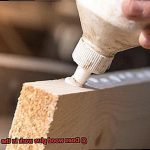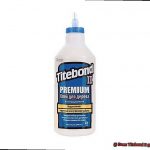In a world buzzing with quick fixes and creative projects, one adhesive reigns supreme: super glue. This mighty adhesive has become the go-to solution for fixing shattered ceramics, bonding wood, or piecing together delicate jewelry components. But what happens when a mishap occurs? Does super glue surrender to a simple splash of water, or does it form an unyielding bond that leaves us frantically searching for answers?
Welcome to this captivating blog post where we unravel the truth behind the age-old question: Does super glue wash off with water? Prepare to embark on an informative journey as we delve into the pros and cons of using this magical adhesive in various scenarios. We’ll also explore the intricate realm of surface compatibility and safe application techniques.
Join us as we unlock the secrets of super glue’s power, uncover which surfaces it can conquer or surrender to, discover effective methods for removing stubborn glue from skin or other surfaces, and learn crucial safety measures when incorporating this potent adhesive into your DIY adventures. Together, let’s separate fact from fiction and dive headfirst into a highly adhesive expedition to reveal whether super glue truly succumbs to the cleansing power of water.
What is Super Glue?
Contents
- 1 What is Super Glue?
- 2 Does Super Glue Wash Off with Water?
- 3 Factors that Determine Whether or Not Super Glue Can Be Washed Off with Water
- 4 Methods for Removing Super Glue with Water
- 5 Alternatives to Washing off Super Glue with Water
- 6 Safety Precautions When Using Solvents and Chemicals to Remove Super Glue
- 6.1 Introduction:
- 6.2 Work in a well-ventilated area:
- 6.3 Protect your skin with gloves:
- 6.4 Shield your eyes:
- 6.5 Dress appropriately:
- 6.6 Have a fire extinguisher nearby:
- 6.7 Read and follow instructions carefully:
- 6.8 Avoid mixing different solvents or chemicals:
- 6.9 Properly store and dispose of solvents and chemicals:
- 6.10 Recognize and respond to adverse reactions:
- 7 Professional Assistance for Removing Super Glue
- 8 Conclusion
Super Glue, also known as cyanoacrylate adhesive, is an exceptional adhesive that has transformed the way we bond materials. Its rapid setting time and formidable strength have made it a household name. In this blog post, we will delve into the properties and versatility of Super Glue, as well as its limitations.
The Science Behind Super Glue:
- Composed primarily of cyanoacrylate, an acrylic resin.
- Clear and low viscosity, enabling it to flow effortlessly into tiny gaps and cracks.
- Reacts chemically upon exposure to moisture, polymerizing and forming robust bonds.
Unparalleled Strength and Quick Setting Time:
- Sets within seconds or minutes, depending on formulation and conditions.
- Ideal for situations requiring immediate adhesion.
- Bonds a wide range of materials: metals, plastics, ceramics, rubber, wood, and even some fabrics.
Distinctive Characteristics:
- Suitable for filling small gaps or cracks due to low viscosity.
- Can be sanded or painted over once cured for a seamless finish.
- Not flexible and may become brittle over time.
Limitations:
- May not be suitable for all materials; certain plastics or surfaces with low surface energy may not provide ideal bonding surfaces.
- Not recommended for constant moisture or water immersion as it may weaken the bond.
- Extreme temperatures or UV light exposure can affect bond strength.
Does Super Glue Wash Off with Water?
Super glue, also known as cyanoacrylate adhesive, is a remarkable adhesive that creates strong bonds in a matter of seconds. However, if you accidentally get some on your skin or a surface you didn’t intend to glue, can it be easily washed off with water alone? The short answer is no. Super glue forms an incredibly strong bond when it comes into contact with moisture, making it difficult to dissolve or wash off with water alone. But fear not. There are several strategies and techniques that can come to your rescue.
- Soaking in Warm, Soapy Water: One method involves soaking the glued area in warm, soapy water. The soap helps break down the adhesive, making it easier to remove. Submerge the affected area in warm, soapy water for a few minutes and then gently rub or peel away the softened glue.
- Acetone or Nail Polish Remover: Another effective technique is using acetone or nail polish remover. Acetone is a powerful solvent that can dissolve super glue. Apply a small amount onto a cotton ball or cloth and gently rub the glued area. This should help loosen the adhesive, allowing it to be wiped away. Use acetone with caution and in a well-ventilated area as it can be harsh on certain surfaces and emit strong fumes.
- Commercial Adhesive Removers: If you’re not comfortable using acetone or nail polish remover, there are also commercial adhesive removers available specifically designed for removing super glue. These products are formulated to break down the adhesive without damaging the surface. Follow the instructions on the packaging for best results.
Remember to be patient and gentle when attempting to remove super glue. Forcefully pulling or scraping at the glue can cause damage to the surface. It’s also important to test any cleaning solution on a small, inconspicuous area before applying it to the glued surface, as some materials may be sensitive to certain chemicals.
In some cases, if the super glue has dried and formed a strong bond, it may be difficult to completely remove it without causing damage. In such situations, it may be necessary to seek professional assistance or consider replacing the affected item or surface.
Factors that Determine Whether or Not Super Glue Can Be Washed Off with Water
Picture this: you’re engrossed in a DIY project, meticulously bonding pieces together with the mighty super glue. Suddenly, a tiny droplet lands on your fingertips, solidifying into an unyielding bond. Panic sets in as you rush to wash it off, only to discover that water alone won’t budge it. What sorcery is at play here? Fear not, for today we delve into the intricate factors that determine whether super glue can be washed off with water, unraveling the secrets behind its indomitable resistance.
The Type of Super Glue:
Not all super glues are created equal. The formulation of the adhesive plays a pivotal role in its washability. Enter cyanoacrylate-based super glues, notorious for their unyielding resistance to water. These glues form robust bonds that are notoriously challenging to break, rendering them less likely to succumb to the power of water alone.
Surface Material Matters:
The material upon which super glue is applied greatly affects its washability. Porous surfaces like wood or fabric provide an inviting habitat for the glue to penetrate and create a vice-like grip. Conversely, non-porous surfaces such as glass or metal offer less purchase for the adhesive, making removal comparatively easier.
Timing is Everything:
When wrestling with super glue, time becomes your ally or adversary. Once applied, it rapidly cures and hardens, transforming into an unyielding bond. If the glue has fully solidified before you attempt to wash it off, water alone may not suffice in dissolving or loosening its grip.
Temperature’s Role:
Temperature can be a formidable ally or an unpredictable opponent in the battle against super glue’s resilience. Cold temperatures render the adhesive more brittle, aiding its removal by causing it to crack or fragment when exposed to water. Conversely, higher temperatures can soften the glue, making it more amenable to removal.
Thickness Does Matter:
The amount of glue applied is a crucial determinant of its washability. Thick layers of super glue demand more time and effort to dissolve or loosen with water compared to thin layers. Moreover, an excessive amount of glue creates a formidable barrier, preventing water from accessing the underlying adhesive and intensifying the challenge of washing it off.
The Duration of Exposure:
The length of time the super glue has been in contact with water is a critical factor. The longer it has had to dry and harden, the stronger its bond becomes, rendering it more impervious to water’s attempts at liberation. Freshly applied glue that has not fully cured may be more susceptible to dissolution or loosening with water.
Methods for Removing Super Glue with Water
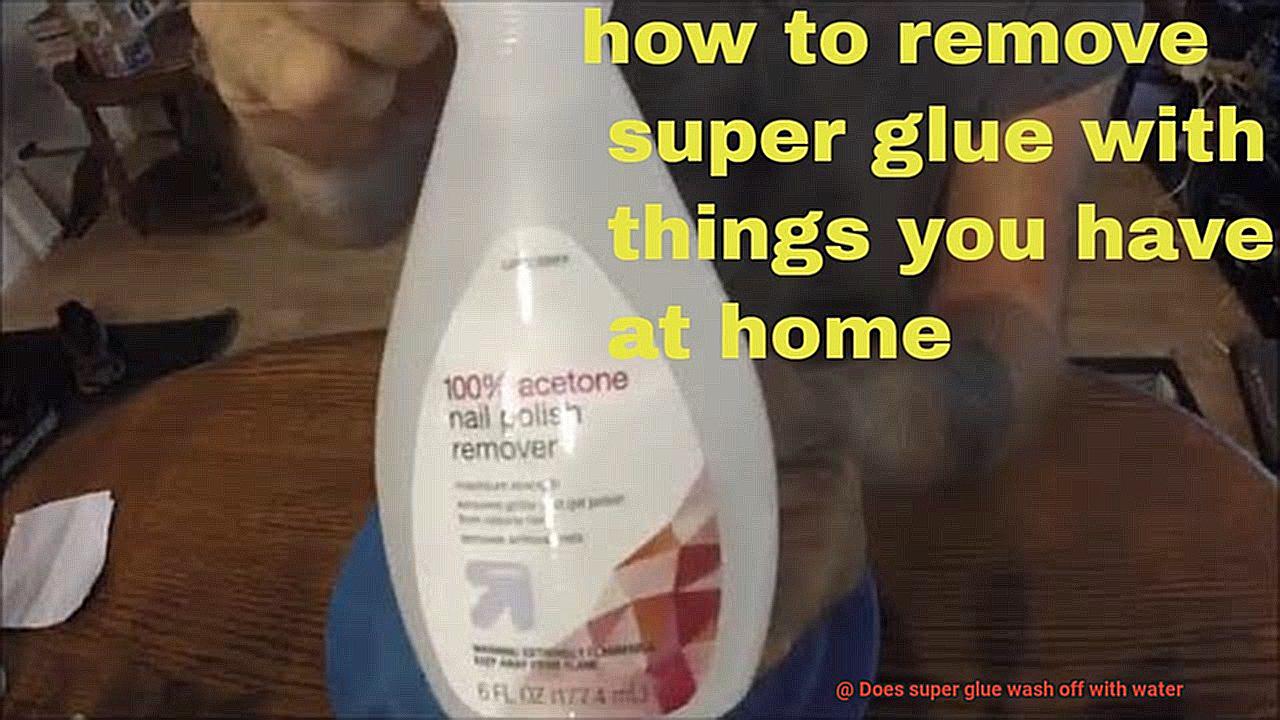
Super glue, or cyanoacrylate adhesive, is a powerful adhesive that bonds materials in seconds. But what happens when it ends up where it shouldn’t be? Fear not. In this article, we’ll explore various methods for removing super glue with water, allowing you to conquer those accidental mishaps like a true glue aficionado.

Method 1: Warm Water Soaking

Soak the affected area in warm water to soften the glue. Gently peel or scrape off the glue using a soft cloth or your fingers.
Method 2: Soap Solution
Add mild soap or dishwashing liquid to warm water. Soak the area and gently scrub with a soft cloth or sponge. Rinse and repeat if needed.
Method 3: Acetone-based Nail Polish Remover
Apply acetone-based nail polish remover to a cotton ball or swab. Dab onto the glued area and wipe away the softened glue with a soft cloth or sponge. Exercise caution as acetone can damage surfaces.
Method 4: Vinegar Solution
Mix equal parts white vinegar and warm water. Dab onto the glue using a clean cloth. Peel off the softened glue with your fingers or a soft cloth. Rinse and repeat if necessary.
Method 5: Commercial Super Glue Removers
Use commercial super glue removers as a last resort. Follow instructions carefully and use in a well-ventilated area.
Alternatives to Washing off Super Glue with Water
There are alternative methods that can help you remove that stubborn adhesive without the need for water. In this article, we will explore these alternatives, providing you with a range of options to choose from.
One popular alternative method is using acetone or nail polish remover. Acetone is a powerful solvent that can break down the super glue and make it easier to remove. Simply apply a small amount of acetone to a cotton ball or cloth and gently rub the affected area. The glue will start to dissolve, allowing you to wipe it away. However, be cautious as acetone can damage certain surfaces such as plastic or painted surfaces. Always test it on a small, inconspicuous area first.
Another option is rubbing alcohol. Soak a cotton ball or cloth in rubbing alcohol and gently rub the glued area. The alcohol will loosen the adhesive properties of the super glue, making it easier to remove. Multiple applications may be necessary, and rinsing with water and mild soap afterward is recommended.
If you prefer a non-chemical approach, heat can also be used as an alternative method. Applying heat to the glued area can soften the glue and make it easier to peel off. Use a hairdryer set to low heat and direct the warm air towards the glued area. Move the hairdryer in a back-and-forth motion to evenly distribute the heat. Once the glue has softened, gently peel it off using a plastic scraper or your fingers. Take care not to burn yourself or damage the surface.
It’s important to note that these alternative methods may not be suitable for all surfaces or situations. Always consult the manufacturer’s instructions or seek professional advice if you are unsure about using these methods on specific materials.
Safety Precautions When Using Solvents and Chemicals to Remove Super Glue
Precautions When Using Solvents and Chemicals to Remove Super Glue
Introduction:
It’s an all too familiar situation – a little too much super glue and suddenly your fingers are stuck together or that precious item is glued to the wrong spot. Fear not, for we have the solution. However, before you dive into the mission of removing that stubborn super glue, don’t forget to prioritize safety. In this article, we will guide you through the necessary precautions to ensure a safe and successful glue removal experience.
Work in a well-ventilated area:
Solvents and chemicals used in glue removers can release fumes or vapors that may be harmful if inhaled. Protect yourself by working in a well-ventilated space. Open windows or use fans to keep fresh air flowing and any potential fumes at bay.
Protect your skin with gloves:
Chemical burns or skin irritation can occur when solvents or chemicals come into direct contact with your skin. Safeguard yourself by wearing protective gloves made of nitrile material, known for its excellent chemical resistance. These gloves act as a barrier between your skin and any potentially harmful substances.
Shield your eyes:
Accidental splashes or contact with solvents and chemicals can lead to eye irritation or injury. Prioritize eye safety by wearing safety glasses or goggles. Your vision is precious – don’t take any risks.
Dress appropriately:
Avoid loose clothing or jewelry that could accidentally come into contact with solvents or chemicals. Loose items might snag on equipment, leading to accidents or spills that can worsen the situation.
Have a fire extinguisher nearby:
Some solvents used in glue removal can be flammable. It’s always wise to have a fire extinguisher within reach in case of accidental ignition. Safety should never be compromised.
Read and follow instructions carefully:
Different products may have specific safety guidelines that must be followed. It’s imperative to read and adhere to the instructions provided by the manufacturer of the solvents or chemicals. Ignoring these guidelines could lead to accidents or ineffective glue removal.
Avoid mixing different solvents or chemicals:
Unless explicitly instructed by the manufacturer, never mix different solvents or chemicals together. The combination of incompatible substances can result in dangerous reactions that may harm you or others. Stick to the instructions and avoid any chemical experiments.
Properly store and dispose of solvents and chemicals:
Store solvents and chemicals in their original containers with properly labeled lids, out of reach of children and pets. When disposing of used solvents or chemicals, follow local regulations. Never pour them down the drain or throw them in regular trash bins.
Recognize and respond to adverse reactions:
If you experience any adverse reactions such as skin irritation, difficulty breathing, or eye discomfort while using solvents or chemicals, stop immediately. Seek medical attention if necessary. Your health and safety should always take priority.
Professional Assistance for Removing Super Glue
Removing super glue can be a challenging task, especially when it ends up in unwanted places like your skin, clothes, or household items. While water can be useful in certain situations, there are times when seeking professional assistance is the best option to ensure safe and effective removal.
When it comes to removing super glue from your skin, small amounts can often be loosened with warm soapy water. However, for larger amounts or completely dried glue, it is advisable to consult a dermatologist or medical professional who can provide specialized treatments or recommend specific products designed for safe super glue removal from the skin. Their expertise will ensure a painless and effective solution.
For delicate fabrics, water can play a role in removing super glue, but caution is key. Before proceeding, test a small inconspicuous area of the fabric to avoid any discoloration or damage. If it’s safe to proceed, soaking the affected area in warm soapy water and gently rubbing it can help loosen the bond. However, if your fabric is delicate or valuable, it’s best to seek professional assistance or use adhesive removers specifically designed for fabrics.
Super glue on countertops, glass, or metal surfaces can be particularly tricky to remove. In these cases, water alone may not do the trick. Instead, consider using gentle abrasives or specialized adhesive removers that are designed for these surfaces. It’s crucial to follow the instructions provided with the adhesive remover and take necessary precautions to avoid damaging the surface. When in doubt, calling in the professionals will ensure that your surfaces are treated safely and effectively.
Accidentally bonding two items together with super glue can be a frustrating situation. Instead of attempting to separate them yourself and risking further damage, it’s best to seek professional assistance. Professional repair services or technicians have the experience and know-how to assess the situation and use appropriate methods and tools to safely separate the bonded items without causing further harm.
Also Read: What Temperature Does Super Glue Melt?
Conclusion
To sum up, the question of whether water can wash off super glue is not a simple one. Water alone may not do the trick, but fear not. There are plenty of tricks and techniques that can come to your rescue.
One method involves immersing the affected area in warm, soapy water. This helps to soften the glue and make it easier to peel or rub off. Another option is acetone or nail polish remover, which acts as a mighty solvent capable of dissolving the adhesive. However, be cautious when using acetone as it can harm certain surfaces.
If all else fails, you can turn to commercial adhesive removers specifically designed for super glue removal. These products are formulated to break down the adhesive without causing any damage.
It’s important to note that various factors come into play when determining if water alone will wash off super glue. The type of glue, the material it’s stuck on, timing, temperature, thickness of application, and duration of exposure all play a role.
Furthermore, safety should always be a top priority when dealing with solvents and chemicals for removing super glue. Make sure you work in a well-ventilated area and wear protective gloves and eye protection. Following instructions carefully is also crucial for your personal safety.
In some instances where super glue forms an unbreakable bond or is on delicate surfaces, seeking professional assistance may be necessary. Dermatologists or medical professionals can provide specialized treatments for removing super glue from skin. Meanwhile, professional repair services or technicians can safely separate bonded items without causing further damage.
To conclude, while water alone might not easily wash off super glue, fear not. There are numerous methods at your disposal for its removal.

